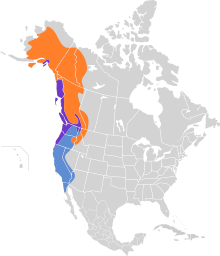Varied thrush
| Varied thrush | |
|---|---|

| |
| Male | |
| Scientific classification | |
| Domain: | Eukaryota |
| Kingdom: | Animalia |
| Phylum: | Chordata |
| Class: | Aves |
| Order: | Passeriformes |
| Family: | Turdidae |
| Genus: | Ixoreus Bonaparte, 1854 |
| Species: | I. naevius
|
| Binomial name | |
| Ixoreus naevius Gmelin, 1789
| |
| Subspecies | |
| |

| |
| Synonyms | |
|
Zoothera naevia | |
The varied thrush (Ixoreus naevius) is a member of the thrush family, Turdidae.
Taxonomy
The German naturalist Johann Friedrich Gmelin described the varied thrush in 1789. Four subspecies are recognised:[2]
- I. n. meruloides – (Swainson, 1832): Found in south Alaska and northwestern Canada
- I. n. naevius – (Gmelin, J.F., 1789): nominate, found in southeastern Alaska and western Canada to west central USA
- I. n. carlottae – (Phillips, A.R., 1991): found in the Queen Charlotte Islands
- I. n. godfreii – (Phillips, A.R., 1991): found in the interior of western Canada to the interior of northwestern USA
The genus name Ixoreus comes from the Ancient Greek ixos, "mistletoe". This was a synonym of a former name for the mockingbird genus, Mimus; the genus creator Bonaparte assumed wrongly that, because Swainson had shown a mockingbird and this thrush on the same plate of his book, they were related. The specific naevius is Latin for "spotted" from naevus, " spot".[3]
Description

The varied thrush is a fairly large thrush species. It can range from 20 to 26 cm (7.9 to 10.2 in) in length and can span 34 to 42 cm (13 to 17 in) across the wings. Body mass can vary from 65 to 100 g (2.3 to 3.5 oz). Among standard measurements, the wing chord is 11.8 to 13.6 cm (4.6 to 5.4 in), the bill is 1.8 to 2.3 cm (0.71 to 0.91 in) and the tarsus is 2.9 to 3.3 cm (1.1 to 1.3 in). It is similar in size to the widespread American robin, though the varied is on average shorter with a heavier, more robust build.[4][5] In general, varied thrushes feature intense orange and black feathers.[6] Adult males exhibit medium orange with a curved gray pattern at the breasts and throats, with grayish-blue tail ends, scruffs, and crowns. They also possess a tufted supraloral stripe and streaks of dark colors on its flight feathers. Its bill is also achromatic, but tan near the bottom of the lower jaw. Its legs are often tawny or dark brown. Females' markings are not as well-defined, with olive-browns and grays, brown hind feathers, and indiscernible gray-brown plumage near the breasts. Young varied thrushes are generally brown, though their stomach feathers are white, and initially harbor two orange stripes at the covert feathers.[7]
There is an extremely rare variant of this species in which all the orange in the plumage is replaced by white.[8] A very rare British vagrant in 1982 was of this type, leading to speculation that whatever mutation causes the colour variation also affects the navigational abilities of this thrush. There have been only five recorded sightings since 1921.[9]
Distribution and habitat
The varied thrush breeds in western North America from Alaska to northern California. It is migratory, with northern breeders moving south within or somewhat beyond the breeding range. Other populations may only move altitudinally. This species is an improbable transatlantic vagrant, but there is an accepted western European record in Great Britain in 1982.[citation needed]
Nests in Alaska, Yukon Territory, and mountains in British Columbia, Washington, and Oregon. Prefers moist conifer forest. Most common in dense, older conifer forests in high elevations. Moves to lower elevations during the winter where it is often seen in towns and orchards and thickets, or migrates to California. Seen in flocks during winter of up to 20 birds. It is well known for individual birds to fly eastward in winter, showing up in just about any state, then returning to the west coast for breeding.
Feeding
The varied thrush is predominantly insectivorous.
Breeding
The breeding habitat is dense coniferous forest, with two to five eggs being laid in a tree nest.
Gallery
-
Varied thrush, Bellevue, WA, USA
-
Male. Distinguishing features include a black breast band on a bright orange breast
References
- ^ Template:IUCN
- ^ Gill, F.; Donsker, D., eds. (2014). "IOC World Bird List (v 4.1)". doi:10.14344/IOC.ML.4.1.
- ^ Jobling, James A (2010). The Helm Dictionary of Scientific Bird Names. London: Christopher Helm. pp. 208, 265. ISBN 978-1-4081-2501-4.
- ^ https://web.archive.org/web/20131022204024/http://www.polarconservation.org/education/arctic-animals/arctic-birds/thrushes-and-chats/varied-thrush. Archived from the original on October 22, 2013. Retrieved August 27, 2012.
{{cite web}}: Missing or empty|title=(help); Unknown parameter|deadurl=ignored (|url-status=suggested) (help) - ^ Peter, Clement (2001). Thrushes. Princeton University Press. ISBN 978-0691088525.
- ^ George 2000, p. 1
- ^ George 2000, p. 2
- ^ Scott, Shirley L., ed. (1987). Field Guide to the Birds of North America (2nd ed.). National Geographic Society. p. 328. ISBN 0-87044-692-4.
- ^ "Bird Walk 71 (photo gallery including photos of rare colour variant)".
Further reading
- George, T. Luke (2000). Poole, A. (ed.). "Varied Thrush (Ixoreus naevius)". Birds of North America (541).
{{cite journal}}: Invalid|ref=harv(help)
External links
- Varied thrush photo gallery at VIREO (Drexel University)
- Varied thrush in Twin Peaks opening theme
- "Varied thrush media". Internet Bird Collection.
- Interactive range map of Ixoreus naevius at IUCN Red List maps
- Audio recordings of Varied thrush on Xeno-canto.
- . New International Encyclopedia. 1905.



